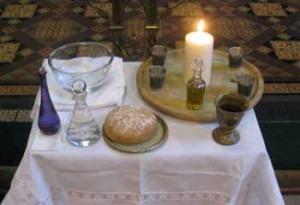The positioning of communication satellites in orbit around the world depends upon precise timing, based upon the use of atomic clocks. With equal precision, but depending upon the relative position of solar system objects, the date of Easter is set. There is a symmetry between the two. One system depends upon the movement of atoms, the other between larger scale rotations of celestial objects. And so we wait for the Sun and the Moon to be in just the right relationship, before we celebrate Easter.
It is this timing that determines the Calendar of the Liturgical Church, the interweaving of an ancient Lunar Calendar with our Solar based Calendar. That this calendar timing should depend upon objects in our solar system is a reflection of the cosmic poetry in the Prologue to St. John’s Gospel. “In the beginning was the Word …. all things came into being through him”.
The work of a Liturgical Church is to ask itself how, in the context of the Liturgical Calendar, do we best express the Biblical Narrative, that is, Salvation History, in worship. The unfolding of the Christian Year, as expressed in the Book of Common Prayer, is the revealing of God’s relationship with Creation, through the seasons. Running in synchronisation with the Christian Year is the Lectionary, an organised, carefully chosen span of Scripture that introduces us to the Word of God. Word, worship and season are then the characteristics of the Liturgical Church, from the anticipation and hope of new birth in Advent, to the long days of summer growth after the fulfilment of the Easter promise. We hope for new birth in the darkness of winter and we celebrate the Light of Christ as new growth reaches out from the warming clay of spring. There is a natural rhythm to our worship.

The winch wire from an Air Sea Rescue Helicopter which has saved lives from water is intertwined with the Cross of Salvation.
Uniquely, the Irish Church has a particular insight to the Liturgy of Easter. In St. Patrick’s Breastplate we read “Christ to shield me to-day against poison, against burning, against drowning, against wounding” (K. Meyer transl.). The Liturgy, or the work of worship, of Easter Eve takes a burning candle, dips it in the waters of baptism, marks it with the wounds and cross of Christ. The story of the Cross tells us of the offering of the sponge dipped in wine and gall or myrrh (poison), and of the wounding in His side. Here are all the elements of the ancient death of four that St. Patrick was standing against.
The task of the Liturgical Church is to express through its work of worship; Word, sound and symbol, that relate the Christian message to the circumstance of our time.

